Child’s Pose in Sanskrit (‘Bala’, means ‘child’, 'asana' means 'pose'). Balasana or Child’s Pose is generally practiced at the end of an intense yoga sequence where the connection of the breath and the movement of the body would have been lost. The practice of Balasana concluding such a sequence, allows one to come to peace with the body with the connection of the breath. No doubt all yoga poses should lead to the connection of the breath and the body, but certain poses are challenging where the chest and the abdomen are compressed or pulled, creating uneasiness with the breathing. With Balasana, the spine remains relaxed in a forward fold and forces one to focus on breathing with the compressing of the abdomen and the chest towards the tummy. On the other hand, Balasana can be used purely as a restorative pose to heal patients with severe backaches, and insomnia, treat blood pressure, or just simply bring stress levels down. Child Pose is considered a base pose as child pose variations can be derived from this pose. Child Pose helps boost energy in the body and hence can be included in different yoga sequences. Child Pose is considered a warm-up and restorative yoga pose to prepare or restore the body before or after more intense yoga poses.
Best Yoga For Sleep And Relaxation

When you hear the word “YOGA”, the first things you think about are strength, flexibility, and stress level. However, it is not necessarily all that but something else, too. Did you know that there is yoga for sleep?
Yoga for sleep is a type that teaches you how to relax and sleep better. For instance, people who have insomnia found out that they sleep better and longer if they practice yoga daily. It helps you to go back to sleep more easily in case you wake up in the middle of the night or just fall asleep faster.
If you think about it, you can see the benefits of yoga in all parts of life. Sometimes your mood is kind of low and all you want to do is eat or go shopping hoping it would make you feel better. Although that might sound like a good idea, it will only make you feel better in the short term. There are numerous studies that show how yoga can decrease levels of the stress hormone – cortisol.
Yoga For Sleep Benefits
To improve your mental health with the help of yoga you don’t need hours practicing every day. All you need is a 15-minute practice and you will notice instant improvements in your health. Here are a few benefits of practicing it.
- Improves your flexibility, strength, and posture. Yoga will improve your flexibility, strength, and posture. Even if you think you are not bendy enough, doing postures like downward dog or the warrior will make you feel different, better, more flexible. You will soon realize that you are walking taller and sitting straighter.
- Speeds up metabolism. Weight loss is another beneficial thing about yoga. By practicing it, if only for 15 minutes a day, your metabolism will change, you will burn fat and start losing weight.
- Boosts Energy. Yoga acts as an energy booster for your body. If you already practiced for some time, you might have noticed that you have more energy after the practice. Practicing yoga on a daily basis will awaken your chakras, connect your body and mind and make you feel positive and energized.
- Decrease the Level of Stress. Studies have shown that if you practice yoga combining the three main elements of yoga; poses, breathing, and meditation, your stress level will lower.
- Improves Mood. Practicing yoga increases serotonin, a hormone responsible for your mood. Doing yoga for only 15 minutes a day at home will change your brain chemistry for the better.
Types Of Yoga For Sleep
There are numerous ways yoga can help you feel better. If you’re anxious, it calms you, if you’re feeling down, it cheers you, and if you can’t sleep it will help you. Sleeping is vital for your whole system to function properly, and if you’re not getting enough sleep you’re more likely to develop some chronic diseases like heart problems, high blood pressure, or severe tiredness. Luckily, the solution might be as simple as a few poses during the day or before bed. The best types of yoga for sleep are Yoga Nidra, Kundalini Yoga, Yin Yoga, Yoga Mudra, Restorative Yoga, and Yoga Breathing for sleep.
- Yoga Nidra. Yoga Nidra is also known as the yogic sleep and it has been more and more popular during the last decade, along with meditation and yoga. It promotes healing and relaxes you in order to calm the mind and decrease the stress hormone. You probably found yourself many times in the state where you think you have fallen asleep but you’re awake. That space in between your sleep and your wakefulness, where you’re just about to enter the state of unconsciousness – that’s Yoga Nidra. The whole point of Yoga Nidra is to keep you in that state for a longer period of time, without letting you fall asleep completely nor letting you be awake. Yoga Nidra can be seen as the perfect combination of meditation and yoga because it usually happens with a guided meditation as your teacher would guide you through in order to reach that state of deep relaxation. If you don’t have a class near you, you can always choose to use the yoga Nidra for sleep audio in the privacy of your home. If you’re suffering from a sleeping disorder, the perfect choice would be Yoga Nidra for deep sleep and insomnia, as it can help you calm your racing brain and shift your focus on winding down instead of thinking about everything and anything you don’t need to be thinking at that moment.
- Kundalini Yoga. It can be said that Kundalini yoga can be challenging, but it can also be comforting. It brings chemical reactions in the body which shift your thinking, physical health, and stress accumulated during the day. Kundalini Yoga has some powerful kriyas and meditations that can help get more sleep. Kundalini Yoga kriyas for sleep are Bandhana Kriya – which is recommended to do right before going to bed in combination with chanting Wha-hay-guroo for 8 times. This kriya is done anywhere from 11 to 31 minutes. Shabd Kriya – is best done right before bed every night, but it can be done any time. Chanting the mantra Sa-Ta-Na-Ma while in this Kriya, will help you stay longer in the deep sleep phase and feel more relaxed
- Yin Yoga. Yin Yoga is the perfect way to prepare for bedtime. When you can’t get yourself to fall asleep at night, you probably have Yin and Yang energies to blame. Yin is the cooling energy and Yang is the heating energy and according to traditional Chinese medicine, determining the balance between the two is the key to getting the best of the night and getting a night of restful sleep.
- Yoga Mudras. Yoga Mudras for deep sleep is the perfect way to find balance in your system and normalize it. Gyan Mudra is very helpful if you’re struggling with insomnia. It also promotes positive thinking and a positive attitude, while reducing negative thoughts altogether. Shakti Mudra is a hand gesture that assists people with severe insomnia by relaxing the body. Vayu Mudra regulates the air in the body. Just like Shakti Mudra, Vayu Mudra is also a hand gesture that helps people with bloating, arthritis, sciatica, and other intestinal problems. Pitta Nashaak Mudra is another hand gesture that works to strengthen the five pranas in our body. It is also known as Pran Mudra. Vaata Naashak Mudra is best for people with chronic fatigue and insomnia. Prithvi Mudra is a hand gesture with the focus on the five main elements of our body
- Restorative Yoga. Practicing restorative yoga for sleep will help you relax and wind down preparing your system for the night. It affects the only fragment of our autonomic nervous system that we can intentionally control – breathing. If we’re breathing calmly and intentionally, that way we regulate our internal energy which will show us the direct path to the deep relaxation state. There are a couple of restorative poses for better sleep, which we will talk about in a minute.
- Yoga Breathing. Although it might not sound like something very interesting, focusing on your breathing can go a long way in helping you fall asleep faster and sleeping better during the night. The roots of yoga are bound upon breathing exercises along with physical activity so no wonder that Breathing yoga compiles the whole set of breathing techniques to help you rest more during the night.
Yoga Poses For Better Sleep
As we mentioned earlier, not all yoga types are meant to relax you – it’s the same with poses. There are specific poses to help you relax and wind down to prepare you for sleep. Let’s talk about some of the best yoga poses for sleep.
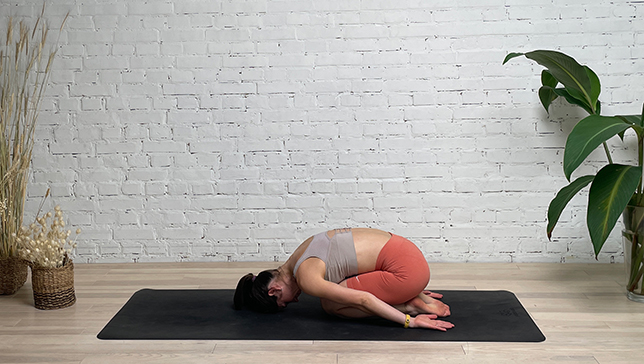
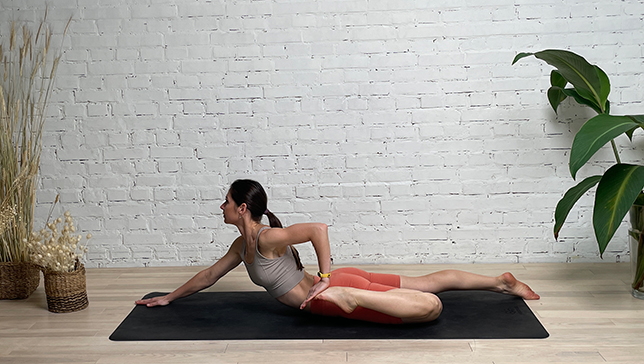
Half Frog Pose or Ardha Bhekasana in Sanskrit, is a beginner-level, hip and back stretch yoga pose to provide strength to hips, feet, knees, chest, neck, and back. The name begins with half or 'ardha' due to its asymmetric behavior which means only one leg is stretched.
The practice of Half Frog Pose is highly effective on the lower back and forming part of the backbend yoga sequence, this pose also helps to open the chest acting as a heart opener too. The pose can be included in daily yoga especially for corporate workers, runners, swimmers, or for complete body flexibility.
Half Frog Pose prepares the hips, legs, and shoulders for other deep back-bending poses like Frog Pose and Bow Pose. Half Frog Pose can be included in Vinyasa Yoga Sequences to strengthen the hips, knees, and ankles for further advanced poses or can be practiced as cooling or counterpose, post the practice of intense hip openers. The pose also has a great effect on the arms including biceps and triceps muscles.
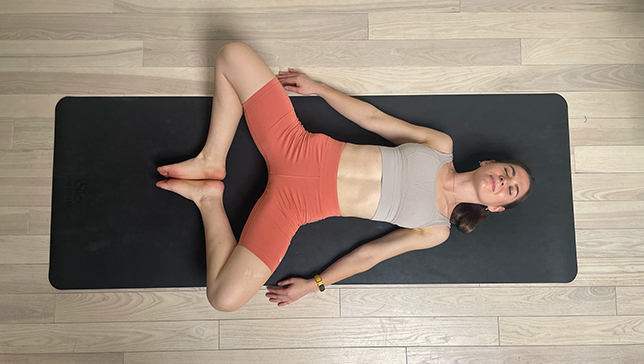
Reclining Bound Angle Pose or Supta Baddha Konasana in Sanskrit (‘supta’=’reclined’, ‘baddha’= ‘bound’, ‘kona' = ‘angle’ or ‘split’ and ‘asana’=’posture’. This pose comes under the category of restorative yoga poses, where while practicing yoga practitioner is more conscious of the body in order to renew energy and calm the nervous system. Generally, this pose concludes a yoga session to end in a beautifully relaxing way to gain control over the body and the mind. The supine position gives rest to the back and the hips and hence this pose is a must as part of every yoga session. Most relaxing yoga poses look easy but they require tremendous effort to bring the mind to focus on the body while the body is relaxed. This only comes through practice. Reclining Bound Angle Pose is considered a base pose as reclining bound angle pose variations can be derived from this pose. Reclining Bound Angle Pose helps boost energy in the body and hence can be included in flow yoga sequences.
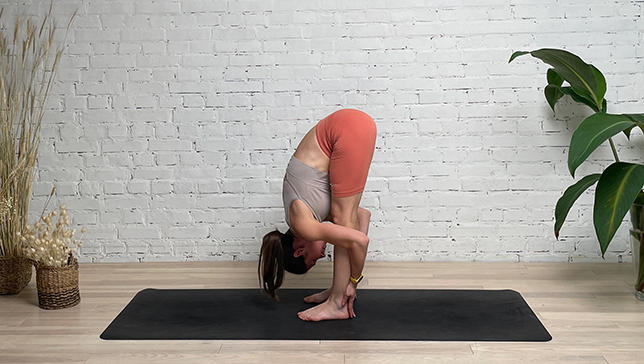
In Standing Forward Bend Pose or Uttanasana in Sanskrit (‘Ut’, means 'intensity' and the ‘Tan’, means 'stretch, extend or lengthen out') the spine is given a deliberate and intense stretch. This yoga pose consists of standing with feet together, bending the upper body at the hips and letting the head hang downwards, and taking control of the body by placing the palms on the floor beside the feet.
This intense forward stretch of the upper body including the spine brings an indirect opening of the hamstring muscles. Standing Forward Bend Pose is considered a base pose as standing forward bend pose variations can be derived from this pose. Standing Forward Bend Pose helps boost energy in the body and hence can be included in flow yoga sequences.
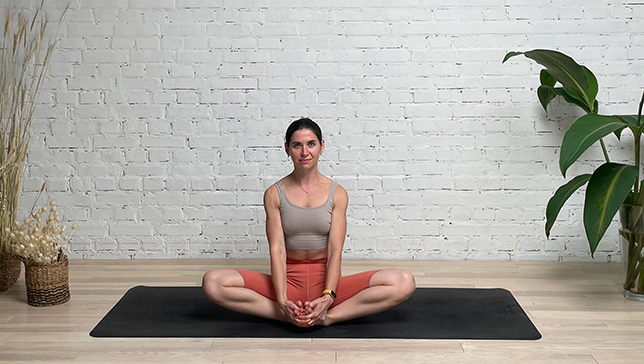
Bound Angle Pose or Baddha Konasana in Sanskrit (Baddha means 'bound', 'caught', 'held', Kona means ‘angle’, and asana means 'pose') is a seated yoga posture that is commonly practiced in many styles of yoga. In other texts, you may find this yoga pose under the name Bhadrasana. The English translation of the Sanskrit term 'Bhadra' is ‘virtuous, pure, prudent, excellent, wise.’ and asana means 'pose'.
Baddha Konasana is a great posture for stretching the inner thighs, groins, and knees, while also opening the hips and improving circulation in the pelvis. It can also help to alleviate menstrual cramps and improve digestion. This is one of the prominent yoga poses mentioned in the Hatha Yoga Pradipika. Bound Angle Pose is considered a base pose as bound angle pose variations can be derived from this pose.
Bound Angle Pose is also known as Cobbler's Pose, Butterfly Pose, and Shoemaker pose.
15 Min Yoga Sequence For Sleep And Relaxation
Wrap Up
People who practice yoga are associated with fewer sleep disorders and good sleep quality, in the long run. If stress is what keeps you up at night, yoga can help you by bringing your focus on your breath or other sensations in your body that you otherwise wouldn’t be aware of. You can do yoga for sleep disorders or Nidra, meditation, or even a combination of the three. It is also crucial that you check with your doctor before starting any kind of fitness routine.
The secret of change is to focus all your energy not on fighting the old, but on building the new.
Socrates
Frequently Asked Questions
While you should avoid certain types of yoga if you’re practicing it to sleep better, like Hot yoga or Vigorous Vinyasa Flow) most yoga types can help you relax your body and calm your mind – which is essential if you want to fall asleep quickly and feel rested in the morning. So the answer to this question would be to choose poses that you’re most comfortable in and try them out for a couple of nights. If you see improvement after some time, continue. If not, try to change poses, and feel free to experiment until you find what works best for you.
There are so many medications that a lot of people take nowadays to sleep better. If you think about it, yoga is a much better option. It’s completely natural and safe. Yoga is a great solution when it comes to sleeping disorders. Harvard University study showed that practicing yoga helps reduce insomnia symptoms. Several medical students who suffered from insomnia learned a couple of yoga poses for sleep. They practiced yoga for eight weeks and wrote down how much they slept and how many times they have woken up during the night. At the end of the study, there were some great improvements in their sleeping conditions. Some benefits of yoga before bedtime are that it reduces stress, depression, and anxiety, calms your mind, renews your body, eases muscle pain, and improves breathing.
Practicing breathing techniques before bedtime can help your body and mind to calm down. It is hard to fall asleep if you have anxiety or you had a stressful day. Deep breaths in combination with a child’s pose can safely get you to calm your racing brain and ease you into a sleeping state.
Doing yoga cannot be bad at any time of day or night. It is the best thing we can give to our bodies. Doing yoga at night releases toxins you’ve been picking up during the day. It calms your mind and takes off the stress. It is like renewing your body, refueling it for another day.


